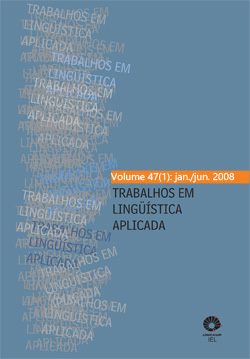Resumo
Este artigo toma como objeto de investigação as narrativas em uma audiência de conciliação do PROCON, em uma cidade de Minas Gerais. A pesquisa é de natureza qualitativa e apresenta um estudo de caso, ancorado nos pressupostos teóricos da Lingüística Interacional. A narrativa é considerada um objeto conversacional, seqüencial e discursivo. O estudo mostra que as narrativas compareceram fundamentalmente nas fases de apresentação da reclamação pelo reclamante e na aceitação ou refutação da reclamação pelo reclamado, fazendo parte do jogo argumentativo na discussão sobre a legalidade nas relações de consumo
ABSTRACT:
This paper investigates narratives in a conciliation hearing at the Product Safety Comisssion in a city in the state of Minas Gerais, Brazil. The research methodology is qualitative, underscored by the theoretical framework of Interactional Linguistics. Narrative is considered as a sequencial, conversational and discursive object. The study shows that narratives are an important linguistic instrument in the complaint presentation’s phase by the complainant and in the acceptance or rejection’s phase by the respondent and are an important part of the argumentation in the discussion on the legality of actions in consume relations.
Keywords: product safety comitee, narrative, complainant/respondent
Referências
DENZIN, N.; LINCOLN, Y. (, 2000). The discipline of qualitative research. Handbook of qualitative research. New York: Sage.
DURANTI, A. (1997). Transcription: from writing to digitized images. In: Duranti, A. Linguistic anthropology. Cambridge: Cambridge University Press.
GARCEZ, P.; LODER, L. (2005). Reparo iniciado e levado a cabo pelo outro na conversa cotidiana em português do Brasil. DELTA, July/Dec. 2005, vol.21, no.2, p.279-312.
GAYNIER, L. P. (2005). Transformative Mediation: In Search of a Theory of Practice. Conflict Resolution Quarterly, v. 22, n. 3.
GOFFMAN, E. (1998). A Situação Negligenciada. Porto Alegre: AGE, Ltda., p.11-15.
_______. (1998). Footing. Porto Alegre: AGE, Ltda., p.70-97.
GOODWIN, C. (1984). Notes on Story Structure and the Organization of Participation. In: Structures of Social Action: Studies in Conversation Analysis. J. Atkinson, J. Heritage, eds., Cambridge: Cambridge U. Press.
GRICE, P. H. (1974). Lógica e Conversação. In: DASCAL, Marcelo (org). Fundamentos metodológicos da lingüística. Pragmática. Campinas, 1982, v 4. Cambridge University Press.
JEFFERSON, G. (1978). Sequential aspects of storytelling in conversation. In: SCHENKEIN, J.N. Studies in the organization of conversational interaction. New York: Academic Press.
LABOV, W. (1972). The Transformation of Experience in Narrative Syntax. In: _______. Language in the inner city. Pennsylvania: University of Pennsylvania Press.
LERNER, G. (1992). ‘Assisted storytelling: Deploying shared knowledge as a practical matter’, Qualitative Sociology 15: 247-71.
POMMERANTZ, A. (1984). Agreeing and disagreeing with second assessments. In: ATKINSON, J.
MAXWELL & HERITAGE., J. Structures of Social Action: Studies in tion Analysis. Cambridge, U.K.: Cambridge University Press.
POMERANTZ, A. & FEHR, B. J. (1997). Coversation Analysis: An Approach to the study of Social Action as Sense Making Practices. In: van DIJK, T. Discourse as Social Action. London: Sage Publications.
PSATHAS, G. (1995). Discovering sequences in interaction. In Conversation Analysis: The Study of Talk in Interaction. Thousand Oaks, CA: Sage.
SACKS, H. (1974). An Analysis of the Course of a Joke’s Telling in Conversation. In: Explorations in the ethnography of speaking. Edited by R. Bauman & J. Sherzer. New York. Cambridge University Press.
_______. (1992). Lectures on Conversation. New York: Blackwell.
_______; SCHEGLOFF, E. & JEFFERSON, G. (1974). Sistemática elementar para a organização da tomada de turnos para a conversa. Revista Veredas de Estudos Lingüísticos, v.7,n.12,p.01-67,2005.
Tradução do original: A Simplest Systematics for the Organization of Turn Taking for Conversation Language, 50 (4), p.696-735.
SCHEGLOFF, E. (1995). Discourse as na Interactional Achievement III: The Omnirelevance of Action.
Research on Language and Social Interaction, vol. 28 (3), p. 185-212.
SELTING, M.; COUPER-KUHLEN, E. (2001). Introduction. In: _______. (Orgs.). Studies in Interactional Linguistics. London: John Benjamins.
ZIMMERMAN, D. H. & BODEN, D. (1991). Structure in Action: An Introduction. In: BODEN, D. & ZIMMERMAN, D. H. Talk & Social Structure: Studies in Ethnomethodology and Conversation Analysis. Los Angeles: University of California Press.
O periódico Trabalhos em Linguística Aplicada utiliza a licença do Creative Commons (CC), preservando assim, a integridade dos artigos em ambiente de acesso aberto, em que:
- A publicação se reserva o direito de efetuar, nos originais, alterações de ordem normativa, ortográfica e gramatical, com vistas a manter o padrão culto da língua, respeitando, porém, o estilo dos autores;
- Os originais não serão devolvidos aos autores;
- Os autores mantêm os direitos totais sobre seus trabalhos publicados na Trabalhos de Linguística Aplicada, ficando sua reimpressão total ou parcial, depósito ou republicação sujeita à indicação de primeira publicação na revista, por meio da licença CC-BY;
- Deve ser consignada a fonte de publicação original;
- As opiniões emitidas pelos autores dos artigos são de sua exclusiva responsabilidade.

